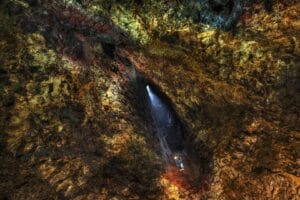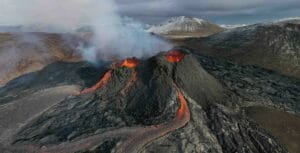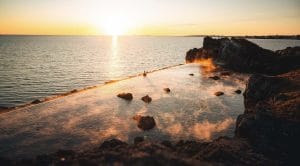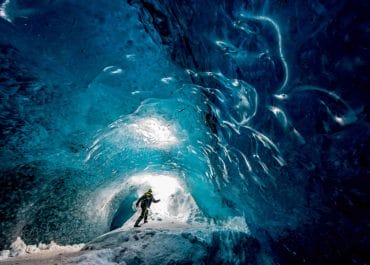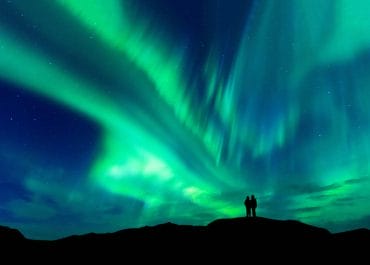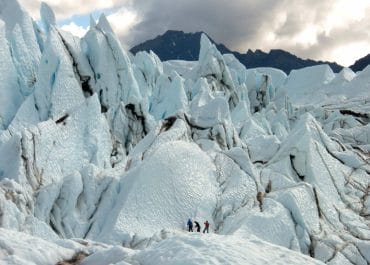There could be many reasons one would visit the land of ice and fire given the fact that the place is crawling with natural landscapes like glaciers, volcanoes, waterfalls, hot springs, and whatnot. While the list of reasons to come to Iceland for your vacation may go on and on, some special things always tend to come before everything else. The Aurora Borealis, also known as the northern lights, is one such thing that makes the tourists visit Iceland for a single attraction instead of the destination as a whole. Many photographers and videographers come to Iceland every season just to click breath-taking pictures of the northern lights and all for good reasons too. These beautiful lights are an exception and appear only in a few selected places on the planet. What makes the northern lights of Iceland special are the extra gorgeous landscapes that can be seen as the backdrop of these lights. This is why northern lights have their separate fan base and tourist base in the country.

What are the Northern Lights? – Science Speaks
Northern lights are these weird but beautiful streams of neon green lights that are seen on the northern or southern pole of our planet. But one may wonder how these lights come into existence. The Aurora Borealis is the result of a solar activity that happens especially on the poles due to the high magnetic force of these two places. Particles are spat out of the sun which is electrically charged. These particles are drawn and picked by the earth on the poles due to their high magnetic force. It takes about 40 hours for these particles to reach near the earth after being spat from the sun. As soon as the particles enter the atmosphere of our planet, they collide and react with several different gasses present in there.
The color of Aurora depends on the collision of these particles with the gases and the altitude of the collision. Every different gas brings froth a different color. For example, oxygen creates a greenish color or a red light which happens only when the collision happens 150 miles above the surface. Green is the most common color to be seen in the northern lights.
The brightness of the lights depends on the said solar activity –more the particles released from the sun, brighter and stronger will be the lights. If you are wondering about the rare blue and purple colored northern lights, then you must know that these colors only appear when the particles travel very close to the earth – about 60 miles above the surface – and collide with nitrogen. Since this barely even happens, these two colors are seldom seen.
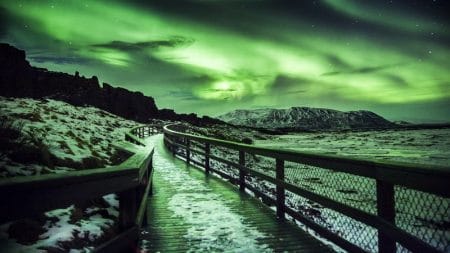
The Ideal Conditions to See Aurora Borealis
The sheer love for nature aside, the truth is that finding the right frame, conditions, places, and ways to get a view of the northern lights is quite challenging. This is probably why the phrase says “hunting the northern lights” as you have to plan, strategize and make many arrangements before you find the ideal spot and time to either sit and gaze towards the glimmering sky or to click that one fabulous picture for which you have been waiting for a long time. Several factors need to be considered to find just the right time to watch the lights since the appearance completely depends on natural phenomena and there is little to nothing that we humans can to do alter them, not that one should try to anyway. Let us explore more about these conditions that need to be met before one can get to spot the lights.
Is it Dark Enough?
Darkness is the biggest factor that needs to fall in line to ensure a powerful display of the aurora. While there is nothing one can do about the natural light, you can plan your hut according to the moon cycle. A full moon does not mean that you won’t be able to see the aurora but the light from this natural satellite lightens up the backdrop. If you are planning to do some professional photography, the moon may come in handy to create a bright background as well.
What about the Unnatural Lights?
Natural light is not as big of an intrusion as the unnatural light from establishments can prove to be. You should get away from the light pollution of the city and travel to a remote location so that there is no artificial hindrance. This is one of those factors that you can control on your own without having to bow down to it.
The Ideal Time Frame
The Winter season of Iceland is considered to be the best time for the year for northern lights viewing. Iceland only gets an average of 4.5 hours of daylight in the core winter season which creates a wider range of hours every single day for you to spot the dancing lights. The darkness is the thing that makes winters the ideal time to find northern lights but they can be spotted in late August to mid April, given that the night sky is enough dark for them to appear.
Crystal Clear Sky
The night may be dark but there is always a possibility that the sky will not be clear which will obstruct the viewing ceremony. Make it point to check the forecast before you set out to camp under the stars. There are several websites managed by the MET department of the country which update the condition of the weather regularly. Just ensure that the sky is going to be clear without any prediction for the clouds to take over.
Solar Activity
The phenomenon itself is also something that you need to keep a track of. Solar activity which causes the northern lights to appear is not always strong enough. There are times when enough particles do now spat out from the sun which means that the collision rate will be lower and hence will result in a weaker aurora even on pitch-black nights with not even a single cloud in sight. This solar activity is measured in terms of the unit ‘kp’ and any value greater than or equal to kp 3 will mean that the solar activity is strong enough for a bright display of the lights. You can keep track of this value through online portals as well.

What Can You Do for Further Betterment of Your Chances?
Camping will go a long way
Most of the camping sites in Iceland are located in remote areas away from the settlements which means that they are free from any kind of light pollution. If you are planning on going for a northern light hunt then camping is the best form of accommodation for you. You will not only get to experience the crude beauty of the country but also have the best chance to spot the aurora in its brightest form.
Note that many campsites in Iceland close during the winter time and it is not recommended to stay in tents over the winter. It is possible to be staying in a camper van, but we do not recommend that you stay in tents during the cold winter months.
Visit the Westfjords or North Iceland
The southern part of Iceland gets most of the rainfall in the country which means that it is highly likely to find a cloudy sky in the southern part. On the contrary, the northern part of the country along with the Westfjords gets the least amount of rainfall and hence experience clearer skies in all seasons. Plan a trip to either of these parts so that you do not have to spend days waiting for the sky to clear up.
Join a Guided Tour
Not that it is not possible to hunt down the lights on a self-driving tour but the fact of the matter is that it comes with a fair share of work cut out for the tourists themselves. You will have to choose the right day, right time, the right vehicle, and the right spot for the hunt while keeping track of the weather predictions and the solar activity. If you think that you would rather sit back and enjoy the view than joining a guided tour is the best way for you to go about. Every tour has northern lights experts who carefully observe all these factors and plan a thoughtful tour for the tourist. Not only that, but you can also even combine northern lights watching tour with some other activities as well if you would like to. Take a look at variety of guided northern lights tours to maximize your chance of seeing the lights dance above you.
Spend as Much Time as Possible under the Stars
Drive, camp, walk, hike, or dive, in short, do anything that you would like to do but stay under the canopy of the stars. A pitch-black sky with stars visible means that there are no clouds and there is no light pollution to obstruct the northern light from showing up.
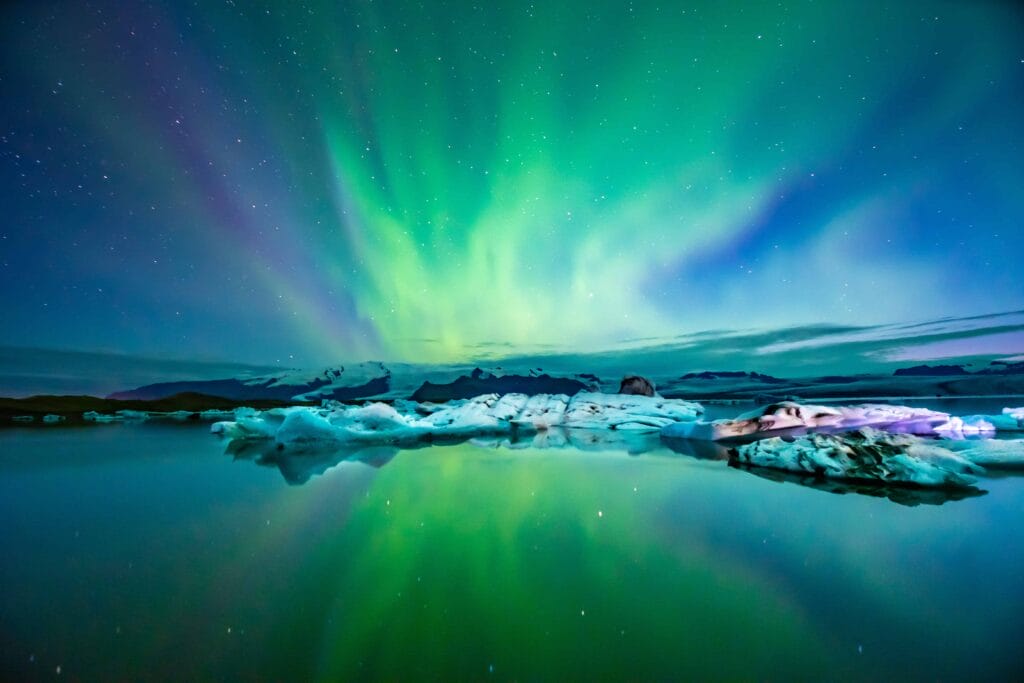
What to Bring on Your Hunt?
It is highly unlikely that when you finally see the Aurora Borealis, you would not take out every kind of camera that you have and start clicking pictures. So, a good camera is something that you need to bring on your hunt. Just make sure that you know all the correct settings for your camera because northern lights photography need a special setting. Some other important things will prove useful on your expedition are listed below:
- Warm Clothes: Since you will be spending a lot of time out in the open, it is smart to wear and packs well-insulated clothing when going on the northern lights hunt. Ensure that you layer up properly because Iceland’s winters are not very kind.
- Snacks and Drinks: Food is very important and there is no guarantee that the path you choose to travel will have a convenience store on the way or not. So, stack up on some snacks especially if you are going on a self-driving tour.
- Sturdy Shoes: You may have to cross some challenging terrains in the search for the perfect spot so sturdy hiking shoes are an important accessory.
- A Good Camera: Even though your phone can click great pictures, carrying a DSLR will be a smart move as the night on which aurora is visible are extra dark. Only professional cameras, that too with some specific settings, can click pictures that are a worthy representation of the beauty of the lights. Keep the ISO setting of your camera between 800-3200. The stronger the aurora, the lesser the ISO. But only go with 800 when the display exceptionally strong. Aperture can stay anywhere between f/2.8 and f/5.6 while shutter speed needs to be adjusted according to the pace of the lights. Very slow-moving lights are photographed at 20-25 seconds shutter speed while the fastest moving lights ever are photographed at a speed of 5-10 seconds. You can read more about photographing the northern lights in this detailed article.
- Spare Batteries: Always keep extra fully-charged batteries handy so that any chance of missing the opportunity of photographing the lights is eliminated.
- Tripod Stand: Stable camera will click better pictures and you will get to click yourself with the northern lights as well.
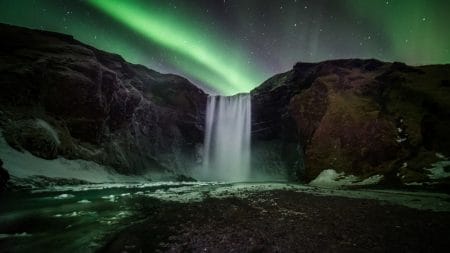
Busting the Myths
It is true that there are many factors that influence the viewing of northern lights. But the inconsistent factors have given rise to some myths about the appearance of the lights as well. As true as these myths may sound to the ear, they remain to be untrue. Let’s bust some myths:
You Cannot See the Aurora on a Full Moon
While darkness is your best friend indeed when it comes to viewing the aurora, it does not mean that the night has to be moon-less for the northern lights to appear. The lights will appear brighter on a new moon night if they happen to appear but a full moon night has an equal amount of probability as any other night for the display of the lights and the presence of the moon brightens up the backdrop.
The Lights Can Only Be Seen When It Is Cold
The best time to see northern lights is indeed from late August to mid April, but that does not make cold weather a factor for the appearance of the lights. This time frame for northern lights viewing exists because Iceland gets the greatest number of dark hours in these few months. While cold weather is not a part of the necessary conditions to be met for the appearance of the lights, the darkness matters a lot. Darker the sky, the brighter the lights will shine. So, even if you feel particularly warm on a winter day in Iceland, you can still northern lights if all other natural pre-requisites are in order.
The Lights Are About to Disappear
Several articles circulate the internet saying that aurora is going to disappear soon and there is a very limited period window left for people to view them. This myth may have surfaced due to the ’11 Years Rule’ of the northern lights. The 11-year rule explains that the solar activity that causes the appearance of the light changes every 11 years in a very significant manner. This does mean the coming cycle may have a lot of change in the colors, strength, or pattern of the lights but it does not necessarily mean that they will disappear. The current level of solar activity is in the declining zone and the lowest level is predicted to be seen in the year 2024. However, this means that the upcoming years after 2024 will see a very high level of solar activity meaning a very strong display of the aurora.
Lights Will Be Visible Every Single Day in Winters
You may set up camp in the most remote area, away from all the light pollution of the city, follow the weather forecast, and regularly keep tabs on the solar activity but there are still chances that you may not be able to see the northern lights on a certain day. Northern Light viewing takes quite a lot of consideration, hard work, and dedication but the results of your wait will be very colorful indeed. It may take a few days to spot the lights so patience is the key here.
Viewing the Aurora Borealis is a very hard task indeed but everyone who wants to see them at least once is well-aware of the fact that all the hard work that Aurora viewing requires is worth every bit. While you will have to be smart and proactive in tracking the weather, clouds and the solar activity, you will also get to enjoy a lot of other things in the process as well for example camping under the night sky, sharing hot cocoa with your fellows or spending some time alone with mother nature, appreciating its beauty. The tour will be as magical as it sounds especially when you ensure that all the ideal conditions are met and there is nothing that would stop you from laying your eyes upon the infamous northern lights.


